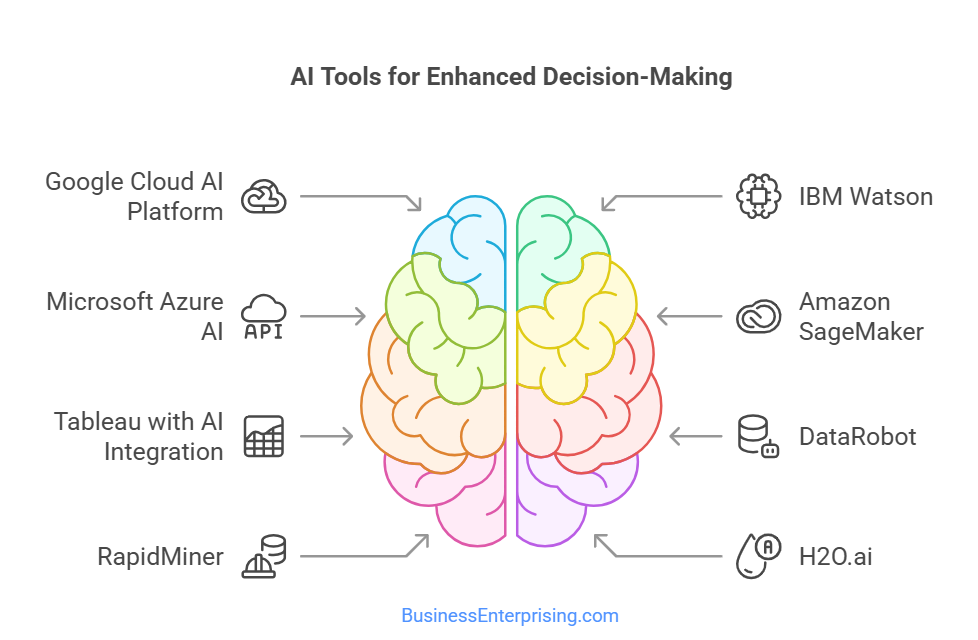
Core technologies like machine learning, natural language processing, and predictive analytics are at the heart of this transformation. Machine learning identifies patterns in data, while natural language processing interprets human language for actionable insights. Predictive analytics uses historical data to forecast future outcomes, enabling you to act proactively rather than reactively.
However, integrating these tools requires more than adopting technology. You must align AI solutions with your goals and ensure they fit seamlessly into your processes. Additionally, focusing on employee training and fostering a data-driven culture positions your team to fully utilize AI’s capabilities. By taking these steps, you can maintain agility and readiness for emerging opportunities.
AI-driven decision-making is not just a trend; it’s a powerful strategy for long-term growth. By leveraging advanced technologies and adapting to an evolving landscape, your business can remain ahead of the curve. The opportunities AI offers are vast, but success depends on your ability to integrate it effectively and strategically.
What is AI-Driven Decision-Making?
AI-driven decision-making uses artificial intelligence to analyze data and make choices, enhancing traditional methods. Unlike conventional approaches that rely on human intuition and experience, AI systems process vast datasets to identify patterns and insights beyond human capacity. This leads to more informed and objective decisions.
Core technologies in AI-driven decision-making include machine learning, natural language processing (NLP), and predictive analytics. Machine learning algorithms learn from data to make predictions or classifications, improving over time. NLP enables machines to understand and interpret human language, facilitating better communication and analysis. Predictive analytics uses historical data to forecast future outcomes, aiding proactive decision-making.
By integrating these technologies, AI systems can evaluate complex information efficiently. This integration allows you to make decisions based on comprehensive data analysis rather than solely on intuition. Consequently, businesses can respond swiftly to market changes, optimize operations, and gain a competitive edge.
The Benefits of AI-Driven Decision-Making for Businesses
AI-driven decision-making offers numerous benefits for businesses by improving efficiency, accuracy, and speed. Unlike traditional methods, AI processes large datasets quickly and identifies patterns humans might miss. This allows you to make better decisions in less time, streamlining workflows and reducing delays.
One significant advantage is cost savings. AI systems automate repetitive tasks and reduce reliance on manual labor, lowering operational expenses. Additionally, they minimize human error, which can be costly and time-consuming to fix. As a result, you can allocate resources more effectively and focus on strategic priorities.
AI also improves scalability. As your business grows, decision-making processes often become more complex. However, AI technologies like machine learning and predictive analytics adapt to increasing data demands without sacrificing accuracy. This flexibility allows you to manage growth with confidence and efficiency.
Moreover, tools like natural language processing make AI-driven systems more accessible and user-friendly. These technologies interpret human language, enabling easier analysis of customer feedback, market trends, and internal communications. With AI-driven decision-making, you gain insights that would otherwise require significant time and effort to uncover.
By adopting AI, businesses can make decisions faster, more accurately, and with greater confidence. These improvements translate into long-term growth, better resource management, and a competitive edge in the market. Transitioning to AI doesn’t just streamline operations—it transforms how you approach challenges and opportunities.
Key Business Areas Where AI-Driven Decisions Excel
AI-driven decision-making has proven transformative across multiple business areas, enabling more efficient and accurate operations. One such area is supply chain optimization. By analyzing demand patterns and inventory levels, AI helps businesses predict shortages and reduce delays. This leads to faster delivery times and cost savings for your operations.
Customer service also benefits significantly from AI. Chatbots powered by natural language processing can handle inquiries 24/7, providing quick responses and freeing up your team for complex issues. Additionally, AI can analyze customer feedback to identify trends and improve product offerings. These tools create a more responsive and personalized experience for your customers.
Marketing is another area where AI-driven decision-making excels. Machine learning models analyze customer behavior to develop targeted campaigns that resonate with specific audiences. Predictive analytics helps you anticipate market trends and allocate budgets effectively. This allows your business to reach the right people at the right time, improving campaign performance.
In financial planning, AI enhances accuracy and efficiency by identifying risks and opportunities through data analysis. Automated systems monitor spending patterns, forecast cash flow, and detect fraudulent activity. With these insights, you can make smarter financial decisions and safeguard your business against potential threats.
AI’s core technologies, such as machine learning, natural language processing, and predictive analytics, power these advancements. By integrating AI into your operations, you can streamline processes, boost efficiency, and gain valuable insights. Across industries, AI-driven decision-making transforms how businesses operate and compete, delivering measurable results and long-term growth.
Challenges and Limitations of AI in Business Decision-Making
AI-driven decision-making brings many benefits, but it also comes with challenges and limitations that businesses must address. One major concern is data privacy. AI systems require large amounts of data to function effectively, but collecting and storing this data raises security risks. You must take steps to protect sensitive information and prevent unauthorized access.
Another challenge involves ethical considerations. AI models may inadvertently reinforce biases present in their training data, leading to unfair outcomes. For example, biased hiring algorithms can perpetuate discrimination if not carefully monitored. Additionally, you must ensure that AI applications align with your ethical standards and societal expectations.
Reliance on incomplete or poor-quality data is another limitation of AI. If the data fed into AI systems is inaccurate or biased, the decisions they produce will reflect those flaws. Therefore, maintaining high-quality datasets is essential to achieving accurate results. Over trust in automated systems can also lead to problems. While AI is powerful, it cannot replace human judgment entirely. You must balance automation with human oversight to avoid costly errors.
The core technologies behind AI, such as machine learning, natural language processing, and predictive analytics, play a significant role in addressing these issues. However, their effectiveness depends on proper implementation and ongoing monitoring. AI-driven decision-making offers significant potential but requires careful management to mitigate risks and avoid unintended consequences. By understanding its limitations, you can make better use of AI and its transformative capabilities.
Implementing AI-Driven Decision-Making: Steps for Success
Implementing AI-driven decision-making requires a thoughtful approach to maximize its potential while minimizing disruptions. Start by identifying your business goals. Consider the specific challenges you aim to address with AI. This step ensures that the chosen tools align with your needs and deliver measurable results.
Next, focus on selecting the right technologies. Machine learning, natural language processing, and predictive analytics are common options, depending on your objectives. However, evaluating vendors and platforms carefully can help you find tools that integrate seamlessly with your existing processes. Scalability and ease of use should also factor into your decision.
Once you select the technology, prioritize employee training. Familiarizing your team with AI tools and their capabilities builds confidence and reduces resistance to change. Additionally, providing ongoing education ensures your workforce stays updated as systems evolve. Without proper training, you risk underutilizing these powerful tools.
Integrating AI into your current workflows requires a clear implementation plan. Start small by automating specific tasks or decision-making areas. For instance, you might apply predictive analytics to forecast demand or optimize scheduling. Gradually expand its use as your team grows comfortable with the technology. Transitioning incrementally minimizes disruptions and allows time to address unforeseen challenges.
Finally, maintain oversight throughout the process. While AI can process data efficiently, human review remains essential to ensure decisions align with your goals. Regularly assessing the performance of AI systems helps you refine their applications and adapt to changing conditions. By following these steps, you can make AI-driven decision-making a practical and effective part of your business strategy.
The Future of AI in Business Decision-Making
The future of AI in business decision-making promises exciting advancements that can reshape how companies operate. One major trend is the rise of explainable AI, or XAI. Unlike traditional AI, XAI provides transparent insights into how decisions are made. This helps you build trust in AI systems and ensures decisions align with ethical and business goals.
Democratized AI tools are also gaining momentum. These technologies make AI more accessible to businesses of all sizes, not just large corporations. For instance, user-friendly platforms allow you to implement machine learning and predictive analytics without needing specialized expertise. As these tools become more widespread, you can integrate AI into everyday operations more easily.
AI-driven innovation will also drive the development of new products and services. Businesses that embrace AI can identify untapped opportunities and predict future trends faster than competitors. For example, natural language processing can analyze customer feedback to inform product design. Predictive analytics will enable you to make proactive decisions in dynamic markets.
To stay ahead in an AI-powered world, focus on adaptability. Prioritize learning about emerging technologies and consider how they might fit into your operations. Additionally, monitor advancements in machine learning, natural language processing, and predictive analytics to maintain a competitive edge. Keeping up with these changes ensures your AI-driven decision-making evolves with the market.
As AI tools continue to advance, businesses that leverage them strategically will benefit the most. With transparent systems, accessible technologies, and innovative approaches, AI’s future holds tremendous potential for transforming decision-making processes. By staying informed and flexible, you can lead in this rapidly evolving landscape.
Conclusion
To thrive in an increasingly AI-powered world, businesses must prioritize adaptability and proactive strategies. AI-driven decision-making offers powerful tools to optimize operations and gain insights, but staying ahead requires ongoing effort. Embracing new technologies while refining existing systems helps you remain competitive and prepared for future challenges.
Core technologies like machine learning, natural language processing, and predictive analytics continue to evolve rapidly. However, keeping pace with these advancements ensures you can leverage their full potential. By monitoring industry trends, you can identify opportunities to improve efficiency and uncover valuable insights. Integrating these tools into your workflows allows you to make data-driven decisions with confidence.
Additionally, investing in training and education is key to success. As AI technologies advance, your team must understand how to use them effectively. Building internal expertise ensures that your organization can adapt to changes and maximize AI’s value. A forward-thinking approach enables you to stay flexible while tackling new opportunities.
AI-driven decision-making has transformed how businesses approach challenges and optimize processes. By committing to continuous improvement, you can make smarter decisions and seize opportunities in a dynamic market. Remaining informed and adaptable positions your business as a leader in the AI era, ready to grow and succeed.



